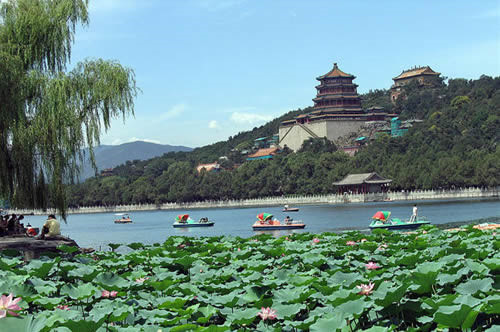Museum of Imperial Garden
皇家园林博物馆(颐和园)
Summer Palace is at the northwest suburb of Beijing,about 15dm from the capital proper.
颐和园在北京的西北郊区,距首都大约十五公里。
Originally it was the Garden of Clear Ripples,built in 1750.Later in 1860 it was burnt down by Anglo-French allied forces.
前身为清漪园,建于1750年。后来在1860年被英法联军烧毁了。
Qing govenment rebuilt it in 1888 with fund set aside for China’s navy,as a place of leisure for Empress Dowager to enjoy her senior years,and accordingly named it with the implication of peaceful and harmonious life.
清朝在1888年拨出中国海军基金重建,作为慈禧太后一个休闲的地方享受晚年,并用和平和和谐的生活的含义命名它含。
The palace occupies about 293 hectares,made up of mainly Longevity Hill and Kunming Lake, with the lake takes up about three fourths of the whole garden.
宫殿占地约293公顷,主要由万寿山和昆明湖两部分组成,其中水面占整个园林的四分之三。
The primary buildings of the palace center on Tower of Buddhist Incense,with over 3 000 towers,pavilions,halls,or houses.
园内建筑的以佛香阁为中心,有3000多间塔,亭台,楼阁,大厅或者房子。
The general design follows the tradition of Chinese landscape construction,and the buildings are arranged in harmony with the natural landform.
总体设计遵循中国的传统景观建筑,建筑与自然地形和谐地安排。
It also borrowed the poetic and other techniques of garden construction in southern China,therefore the palace is not only imperial and grand but also elegant and rich with variation.
花园建设汲取江南园林的某些设计手法和意境,因此宫殿不仅恢弘富丽气势而且富有变化。
It is a perfect combination of the natural landscape and human features full of artistic impact.
它是自然景观和人类特性艺术影响一个的完美结合。
The palace is highly valued not only in the sense of its landscape art but also its role in science and history,which ranks it among the most world famous resorts of tourists. In 1998 World Heritage Committee of UNESCO inscribed it in World Heritage List.
颐和园之所以受到高度重视不仅是由于其景观艺术,还有它在科学和历史的角色,它是世界最著名的度假胜地之一。1998年被联合国教科文组织世界遗产委员会列入世界遗产名录。
The palace is the largest royal garden in the world most perfectly preserved with the richest cultural connotation,hence honored as a museum of royal gardens.
颐和园是世界上最大的保存最完好的皇家花园,富有丰富的文化内涵,因此誉为皇家园林博物馆。

Its general layout makes full use of the hill and the lake,together with the borrowed views from the peaks of the west mountains,which brings about infinite scenery variations with exceeding beauty.
其总体布局充分利用山和湖,凭借西部山脉的山峰,能看到无限的风景,极其美丽。
The buildings in the palace are the architectural cream from all parts of China. The administrative and residential areas in the east of the palace are typical of the quadrangle in northern China,where the enclosed courtyards are connected by various roofed causeways.
颐和园的建筑是建筑材料来自中国各地。行政区和东部的居民区是中国北方典型的四合院,封闭的庭院由有屋顶的通道连接。
he lake area in its south, however,is an imitation of West Lake of Hangzhou,where a dyke divides the lake in two,thus giving it an obvious touch of southern China landscape.
但是南部的湖区仿杭州西湖,一个堤坝将其分成两个湖,因此和中国南方景观有明显的联系。
On the north side of Longevity Hill, the scene is that of Tibetan lamasery, where stand white pagodas and buildings like blockhouses.
北侧的万寿山,景观是西藏喇嘛庙,有白色佛塔,建筑物像堡垒。
And in the north, the Suzhou Market Street, with all kinds of shops and its crisscrossing water courses, is again in the style of the waterscape in southern China.
在北面,苏州市场街有各种各样的商店及来往河道,是中国南方水景风格的再现。












